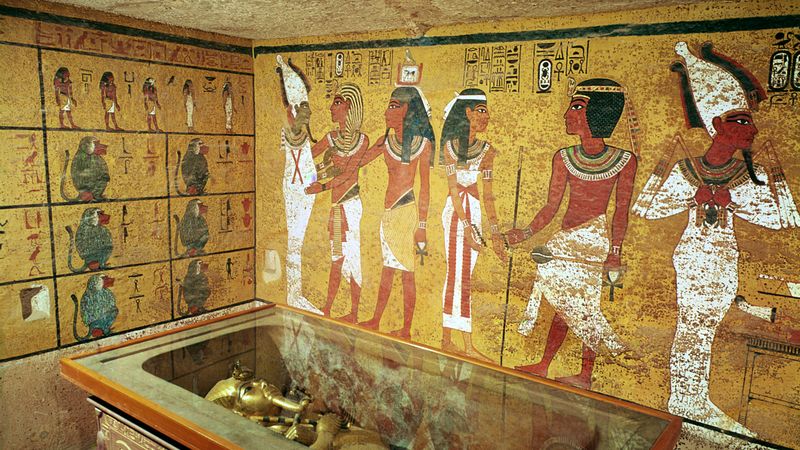
Discover the Tomb of Tutankhamun :7 Mysteries Secrets
The Discovery of the Tomb of Tutankhamun
The discovery of the tomb of Tutankhamun in 1922 stands as one of the most significant archaeological finds of the 20th century. Nestled in Egypt’s Valley of the Kings, this remarkable event captivated the world and offered a unique glimpse into the opulent life of ancient Egyptian royalty.
The Journey to Discovery
The story begins with Howard Carter, a dedicated British archaeologist, who was convinced that the Valley of the Kings still held secrets. Funded by Lord Carnarvon, Carter embarked on a quest that many thought was futile. However, his persistence paid off when, on November 4, 1922, his team uncovered a set of steps leading to a sealed doorway. This moment marked the beginning of the discovery of the tomb of Tutankhamun.
On November 26, Carter made a small breach in the door and peered inside. When asked by Lord Carnarvon if he could see anything, Carter famously replied, “Yes, wonderful things.” This marked the official discovery of the tomb of Tutankhamun, a moment that would echo through history.
The Treasures Within
The tomb, remarkably intact, contained over 5,000 artifacts. These treasures provided an unprecedented look into the life and death of the young pharaoh. Among the items were golden chariots, intricate jewelry, and a wealth of everyday objects. The most iconic find was the burial mask of Tutankhamun, crafted from gold and inlaid with semi-precious stones, symbolizing the grandeur of ancient Egyptian craftsmanship.
Who Was Tutankhamun?
Tutankhamun, often called the “Boy King,” ascended to the throne at around nine years old and ruled for about a decade. Although his reign was short and not particularly notable for military or political achievements, the discovery of the tomb of Tutankhamun immortalized him as one of the most famous pharaohs.
His significance lies in his role in restoring traditional Egyptian religion and art after the radical changes of his predecessor, Akhenaten. Tutankhamun’s return to polytheism helped stabilize the kingdom during a turbulent period.
The Mystery of His Death
The cause of Tutankhamun’s death has been a topic of speculation. Initial theories suggested murder due to a blow to the head, but recent studies, including CT scans and DNA analysis, indicate he likely died from complications of a broken leg, possibly worsened by malaria. These findings suggest a young king beset by health challenges, including a cleft palate and a club foot.
The Impact of the Discovery
The discovery of the tomb of Tutankhamun had a profound impact on archaeology and popular culture. It sparked a global fascination with ancient Egypt, often referred to as “Tutmania.” The artifacts toured the world, drawing millions of visitors and inspiring countless books, films, and exhibitions.
For archaeologists, the tomb provided invaluable insights into burial practices, art, and daily life in ancient Egypt. It also underscored the importance of meticulous excavation techniques and the preservation of artifacts.
The Curse of the Pharaoh
The discovery of the tomb of Tutankhamun also gave rise to the infamous “Curse of the Pharaoh.” Following the excavation, several people associated with the discovery, including Lord Carnarvon, died under mysterious circumstances. This led to sensational stories of a curse on those who disturbed the pharaoh’s rest.
While the curse made for thrilling headlines, most historians and scientists dismiss it as myth. The deaths can be attributed to natural causes, and many key figures involved in the discovery lived long, healthy lives.
Preserving the Legacy
Today, the treasures from the discovery of the tomb of Tutankhamun are housed in the Grand Egyptian Museum in Giza. The museum’s state-of-the-art facilities ensure these artifacts are preserved for future generations to study and admire.
The discovery of the tomb of Tutankhamun remains a landmark event in archaeology. It enriched our understanding of ancient Egypt and inspired a lasting fascination with the mysteries of the past. As we continue to explore and learn from these ancient
treasures, the legacy of the Boy King endures, reminding us of the timeless allure of history and the stories it holds.
Related:
10 Incredible Facts About the Valley of Kings You Must Know (sunpyramid-tours.com)
Recent Posts
Edfu Temple :5 Reasons to Explore the Majestic Today
Discover 7 Amazing Features of Sinbad Hotel Egypt for 2024
Top 7 Reasons to choose Egypt Air Hospital in Egypt
All Categories
Tags

Thailand






